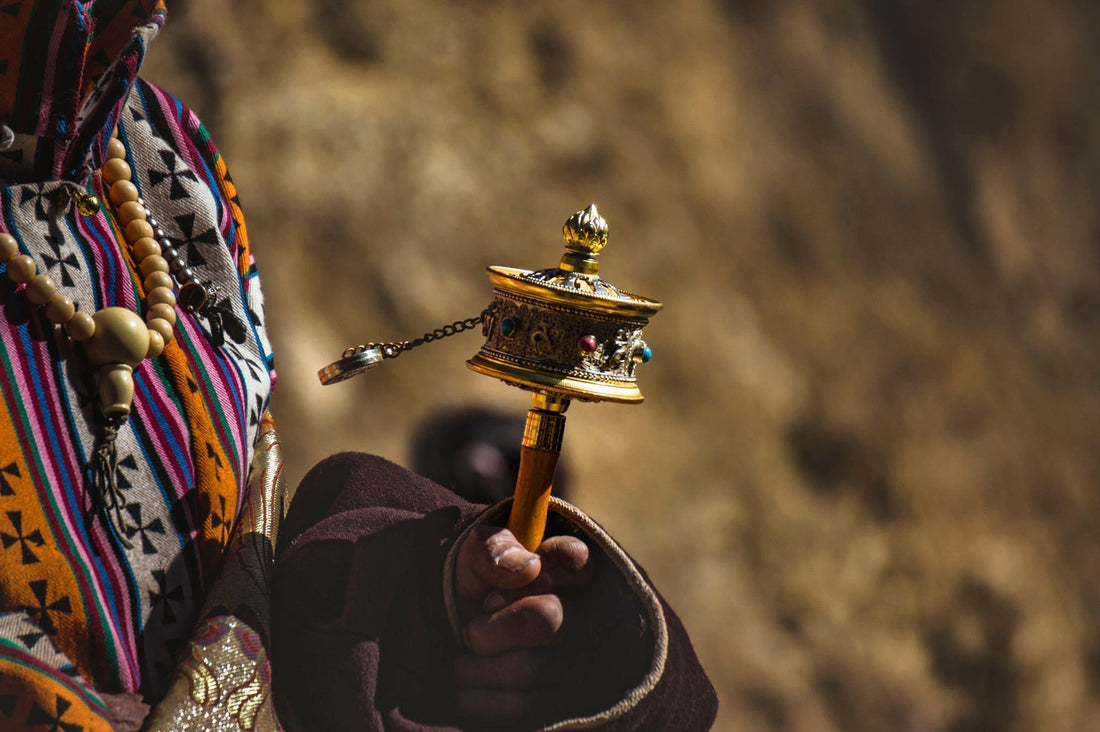
The Symbolism of Prayer Flags in Tibetan Buddhism
Introduction: What Are Tibetan Prayer Flags?
Tibetan prayer flags are one of the most recognizable symbols of Tibetan Buddhism, often seen fluttering in the wind across mountain passes, monasteries, homes, and sacred sites. These colorful flags are not mere decorations—they carry deep spiritual significance and serve as a medium for spreading prayers, blessings, and compassion to all beings.
In this blog, we’ll explore the history, symbolism, and meaning of Tibetan prayer flags, as well as how they are used in daily life and rituals.
1. The History of Tibetan Prayer Flags
Prayer flags have their origins in ancient Buddhist and Bon traditions. Early forms of prayer flags were believed to have been used in India, where they symbolized protection and carried invocations to deities. When Buddhism spread to Tibet, the practice evolved into the prayer flags we recognize today.
Connection to the Elements:
Tibetan culture emphasizes harmony with the natural world, and prayer flags reflect this connection by interacting with the elements of wind, sun, and air.
Spiritual Purpose:
Prayer flags are tools for promoting peace, compassion, strength, and wisdom. They are believed to carry prayers and blessings across the wind to benefit all beings.
2. The Five Colors and Their Symbolism
Tibetan prayer flags come in five colors that represent the five elements, as well as the five wisdoms of Buddhism. Each color has a unique meaning:
1. Blue:
Represents the sky and space.
Symbolizes purity and healing.
2. White:
Represents air and wind.
Symbolizes balance and new beginnings.
3. Red:
Represents fire.
Symbolizes energy and transformation.
4. Green:
Represents water.
Symbolizes harmony and growth.
5. Yellow:
Represents earth.
Symbolizes stability and grounding.
The arrangement of these flags in this specific order reflects the harmony between nature and the universe, promoting balance and well-being.
3. The Texts and Images on Prayer Flags
Prayer flags are printed with sacred texts, symbols, and imagery, each carrying profound spiritual significance.
Sacred Mantras:
Common mantras, such as "Om Mani Padme Hum", are printed on the flags to invoke the blessings of Avalokiteshvara, the Bodhisattva of Compassion.
Symbols:
Wind Horse (Lungta): Represents strength and good fortune.
Deities and Protectors: Images of Buddhas, Bodhisattvas, and protective deities adorn the flags to invoke their guidance and blessings.
Prayers:
Written prayers for peace, wisdom, and compassion are included to benefit all beings.
The wind carries these sacred prayers and symbols into the world, spreading positive energy far beyond the physical location of the flags.
4. How Prayer Flags Are Used
Prayer flags are used in a variety of ways in Tibetan Buddhism, from personal practice to larger ceremonies and festivals.
Placing Prayer Flags:
Flags are often hung in high places, such as mountain passes or rooftops, where the wind can carry their blessings far and wide.
They are typically placed on auspicious days and with a pure heart to ensure their effectiveness.
Renewing Prayer Flags:
Over time, prayer flags fade and fray, symbolizing the impermanence of life. When replacing old flags, they are respectfully removed and burned to release their energy.
During Ceremonies:
Prayer flags are often raised during Buddhist ceremonies, such as Losar (Tibetan New Year), to mark new beginnings and invoke blessings.
The act of hanging prayer flags is itself a spiritual practice, reminding practitioners of the interconnectedness of all beings.
5. The Spiritual Message of Prayer Flags
At their core, Tibetan prayer flags embody the principle of selflessness. They are designed not to benefit the individuals who hang them, but to spread blessings and positive energy to all sentient beings.
Compassion and Interdependence:
The prayers and mantras on the flags are meant to dissolve the boundaries between self and others, fostering compassion and awareness of our shared existence.
Harmony with Nature:
The interaction of the flags with the wind symbolizes the harmony between the spiritual and natural worlds.
Impermanence:
The fading of prayer flags over time reminds practitioners of the impermanence of life, a central teaching in Buddhism.
Prayer flags serve as a quiet but powerful reminder of the values of Tibetan Buddhism, encouraging practitioners to live with mindfulness, compassion, and humility.
6. How to Incorporate Prayer Flags into Your Life
Even if you’re not in Tibet, you can incorporate prayer flags into your spiritual practice in meaningful ways:
Create a Sacred Space:
Hang prayer flags in your home, garden, or meditation space to create an atmosphere of peace and positivity.
Offer Prayers with Intention:
While hanging the flags, set clear intentions for the well-being of all beings and dedicate the act to spreading compassion.
Respect the Flags:
Treat prayer flags with reverence, avoiding placing them on the ground or using them for decoration without understanding their spiritual significance.
Work with the Elements:
Hang your flags in a place where the wind can touch them, allowing their blessings to reach the world.
By embracing the practice of using prayer flags, you can align your life with the values of compassion, harmony, and mindfulness.
Conclusion: Spreading Blessings with Tibetan Prayer Flags
Tibetan prayer flags are more than just beautiful decorations—they are sacred tools for promoting peace, compassion, and spiritual growth. Each flag, with its vibrant colors and sacred texts, carries prayers and blessings into the world, reminding us of our interconnectedness and the impermanence of life.
By incorporating prayer flags into your practice, you can create a bridge between your spiritual aspirations and the world around you, spreading positivity and blessings far and wide.